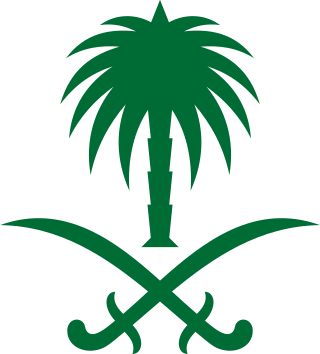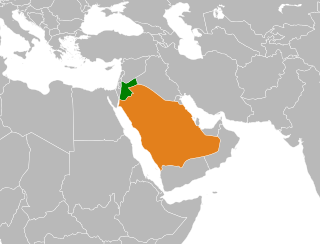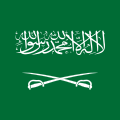
The history of Saudi Arabia as a nation state began with the emergence of the Al Saud dynasty in central Arabia in 1727 and the subsequent establishment of the Emirate of Diriyah. Pre-Islamic Arabia, the territory that constitutes modern Saudi Arabia, was the site of several ancient cultures and civilizations; the prehistory of Saudi Arabia shows some of the earliest traces of human activity in the world.

Abdulaziz bin Abdul Rahman Al Saud, known in the Western world mononymously as Ibn Saud, was the founder and first king of Saudi Arabia, reigning from 23 September 1932 until his death in 1953. He had ruled parts of the kingdom since 1902, having previously been Emir, Sultan, and King of Nejd, and King of Hejaz.

The national flag of Saudi Arabia is a green background with Arabic inscription and a sword in white. The inscription is the Islamic creed, or shahada: "There is no deity but God; Muhammad is the Messenger of God". The current design has been used by the government of Saudi Arabia since 15 March 1973.

The House of Al Saud is the ruling royal family of Saudi Arabia. It is composed of the descendants of Muhammad bin Saud, founder of the Emirate of Diriyah, known as the First Saudi State, (1727–1818), and his brothers, though the ruling faction of the family is primarily led by the descendants of Ibn Saud, the modern founder of Saudi Arabia. It forms a subtribe of the larger prominent ancient Banu Hanifa tribe of Arabia, from which well known 7th century Arabian theologist Maslama ibn Ḥabīb originates. The most influential position of the royal family is the King of Saudi Arabia, an absolute monarch. The family in total is estimated to comprise 15,000 members; however, the majority of power, influence and wealth is possessed by a group of about 2,000 of them. Some estimates of the royal family's wealth measure their net worth at $1.4 trillion. This figure includes the market capitalization of Saudi Aramco, the state oil and gas company, and its vast assets in fossil fuel reserves, making them the wealthiest family in the world and the wealthiest in recorded history.

The Saudi–Yemeni war was a war between Saudi Arabia and the Kingdom of Yemen in 1934.

The Sultanate of Nejd was the third iteration of the Third Saudi State, from 1921 to 1926. It was a monarchy led by the House of Saud, and a legal predecessor of modern-day Saudi Arabia. This version of the Third Saudi State was created when Abdul Aziz ibn Saud, Emir of Riyadh, declared himself sultan over Nejd and its dependencies. On the 2 December 1922, the Nejd signed an agreement with Kuwait defining their border with each other. The border would be a straight line along the 29th parallel. In December 1925, the Kingdom of Hejaz surrendered to the forces of Abdul Aziz ibn Saud, who was thereafter proclaimed king of Hejaz in January 1926 and merged his dominions into the Kingdom of Hejaz and Nejd.

The unification of Saudi Arabia was a military and political campaign in which the various tribes, sheikhdoms, city-states, emirates, and kingdoms of most of the central Arabian Peninsula were conquered by the House of Saud, or Al Saud. Unification started in 1902 and continued until 1932, when the Kingdom of Saudi Arabia was proclaimed under the leadership of Abdulaziz, known in the West as Ibn Saud, creating what is sometimes referred to as the Third Saudi State, to differentiate it from the Emirate of Diriyah, the First Saudi State and the Emirate of Nejd, the Second Saudi State, also House of Saud states.

The Third Saudi state is the heir to the two earlier Saudi states: the first and the second, founded by Abdul Aziz bin Abdul Rahman, who managed to capture the city of Riyadh on January 13, 1902. A long series of conflicts and conquests ultimately led to the establishment of the modern and contemporary Saudi state, the Kingdom of Saudi Arabia.

The Allegiance Council, also known as the Allegiance Commission or Allegiance Institution or Succession Commission, is the body responsible for determining future succession to the throne of Saudi Arabia. It was formed on 7 December 2007 by King Abdullah. At the time of its formation, the Council's intended function was to appoint a Crown Prince once a new King succeeds to the throne.

The Emirate of Riyadh was the first iteration of the Third Saudi State from 1902 to 1913. It was a monarchy led by the House of Saud. The state was formed after Saudi forces seized Riyadh from the control of the Emirate of Ha'il, led by the House of Rashid, during the Battle of Riyadh. It was the direct antecedent of the Emirate of Nejd and Hasa, and the earliest legal predecessor of present-day Saudi Arabia. Al-Hasa was conquered in 1913.
The Saudi conquest of Hejaz or the Second Saudi-Hashemite War, also known as the Hejaz-Nejd War, was a campaign by Abdulaziz al-Saud of the Saudi Sultanate of Nejd to take over the Hashemite Kingdom of Hejaz in 1924–25, ending with conquest and incorporation of Hejaz into the Saudi domain.

Jordan–Saudi Arabia relations are characterized by mutual recognition and exchange of embassies.
The First Saudi–Hashemite War, also known as the First Nejd–Hejaz War or the al-Khurma dispute, took place in 1918–19 between Abdulaziz Ibn Saud of the Emirate of Nejd and Hasa and the Hashemites of the Kingdom of Hejaz.

Saudi National Day is a public holiday in Saudi Arabia celebrated annually on 23 September to commemorate the proclamation that renamed the Kingdom of Nejd and Hejaz as the Kingdom of Saudi Arabia in 1932 through a royal decree by King Abdulaziz ibn Saud. It was founded in 1965 by King Faisal bin Abdulaziz in order to replace the Royal Seating Day, but at the same time letting it retain its predecessor's year count of 1930 instead of 1932. It was made a public holiday by King Abdullah bin Abdulaziz in 2005 and is one of the three non-religious holidays observed in the country, other being the Saudi Founding Day and Saudi Flag Day.

The Crown Prince of Saudi Arabia is the second-most important position in Saudi Arabia, second to the King, and is his designated successor. Currently, the Crown Prince assumes power with the approval of the Allegiance Council after he is nominated by the King. This system was introduced to the country during the reign of King Abdullah. In the absence of the King, an order is issued to have the Crown Prince manage the affairs of the state until the King's return.

The Ministry of Education(MoE) (Arabic: وزارة التعليم), known before 2003 as the Ministry of Knowledge and until 1953 as the Directorate of Knowledge, is a government ministry in Saudi Arabia that is responsible for regulating primary, secondary and higher education in the country. It was established in 1926 by King Abdulaziz ibn Saud in the Kingdom of Nejd and Hejaz. Since the amalgamations of the General Presidency for Girls' Education (GPGE) in 2002 and the Ministry of Higher Education (MOHE) in 2015, it became the sole body which supervises all schools, universities and colleges in the country.
Abdullah bin Thunayan Al Saud was Emir of Nejd from 1841 to May 1843. He is the sole member of the Al Thunayan branch of the Al Saud who became emir.

The Declaration of theUnification of Saudi Arabia was officially announced by Prince Faisal bin Abdulaziz, the Viceroy of Hejaz and future monarch on behalf of King Abdulaziz ibn Saud on September 23, 1932, at 9:00 am from al-Hamidiyah Palace in Mecca. Faisal read out the Royal Decree No. 2716 issued by Abdulaziz ibn Saud on September 18, 1932, that renamed the Kingdom of Hejaz and Nejd and its annexes as the Kingdom of Saudi Arabia.

Saudi Founding Day, officially the Founding Day, is a public holiday in Saudi Arabia celebrated annually on February 22 to commemorate the enthronement of Muhammad bin Saud as the emir of the oasis town of Diriyah in 1727 following the death of his father Saud al-Muqrin, the eponymous ancestor of the al-Saud family. His hereditary succession is considered as the prelude to the inception of the First Saudi State, the antecedent to the Second Saudi State and present-day Kingdom of Saudi Arabia. It was founded in 2022 on its 295th anniversary when King Salman bin Abdulaziz issued a royal decree that designated it as a legal holiday to be observed as per the Gregorian calendar. It is one of the three non-religious national holidays observed in the country, other being the Saudi National Day and Saudi Flag Day.











































